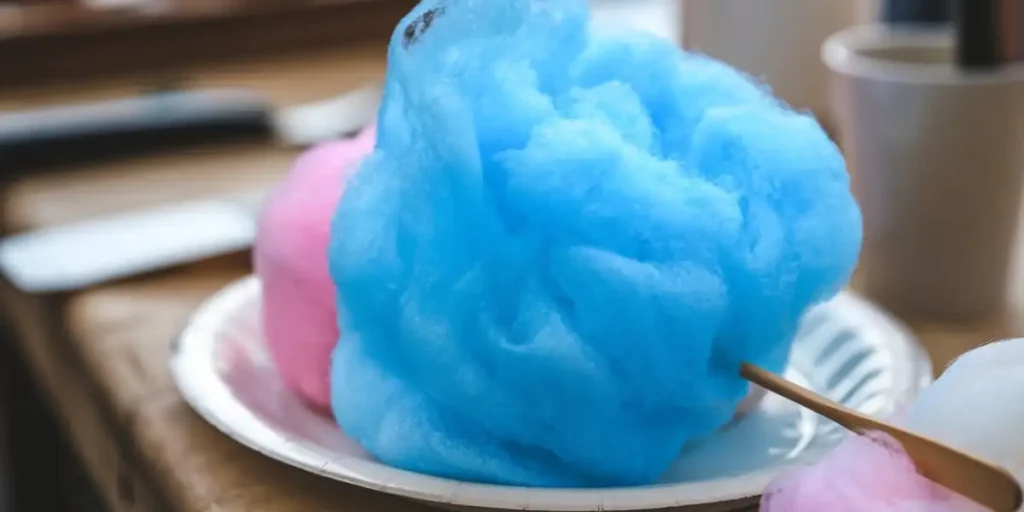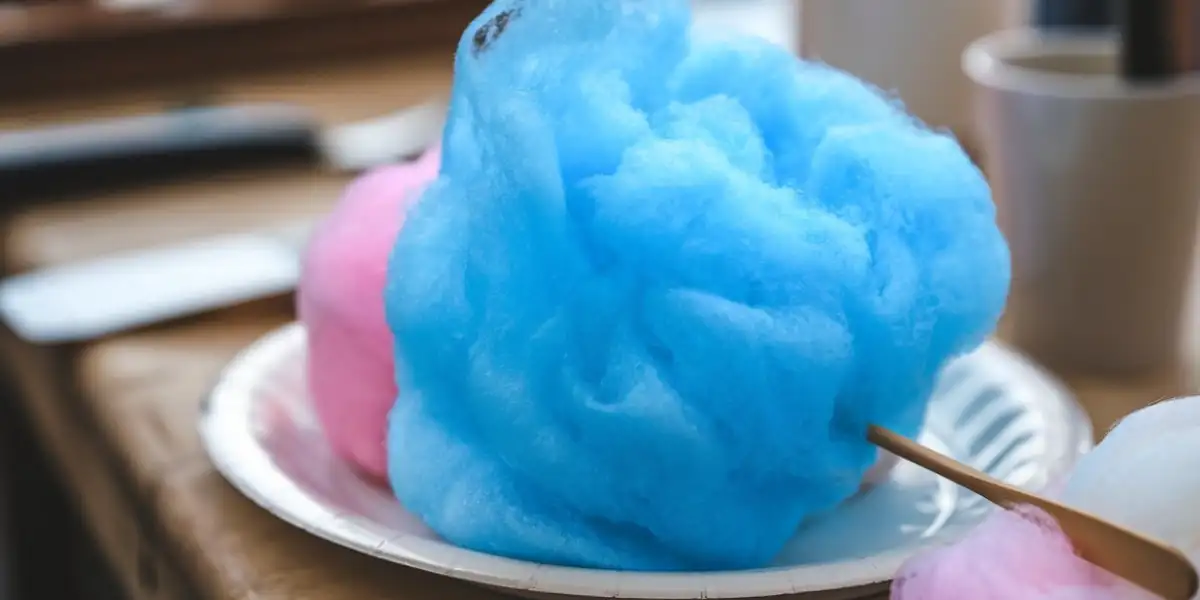
Table of Contents
Ready to spin fair-ground magic at home? Blue cotton candy turns ordinary sugar into sky-colored clouds with just a dash of blueberry extract and natural dye. After testing three flavor–color ratios, I locked in a recipe that keeps the hue vibrant and the melt-on-the-tongue texture perfect.
What is Blue cotton candy?
Blue cotton candy is a sweet and fluffy treat that has captured the hearts of children and adults alike. This iconic carnival snack owes its vibrant hue to food coloring, typically paired with a flavor like blue raspberry or bubblegum. Its electric blue shade is not only eye-catching but also creates a sense of excitement, making it a popular choice at fairs and festivals.
The combination of flavor and color makes blue cotton candy unique. Unlike its pink counterpart, which often carries a vanilla or strawberry flavor, blue varieties offer a fruity and tangy experience. These subtle differences highlight the role color plays in how we perceive taste. For instance, many people associate the color blue with refreshing flavors, adding to its widespread appeal.
Making blue cotton candy involves spinning sugar into thin threads, a process that relies on heat and centrifugal force. As the sugar melts, the machine spins it into fine strands, which then cool rapidly to create the light and fluffy texture we love. The addition of food coloring and flavoring transforms plain sugar into a vibrant, flavorful treat. For tips on storing cotton candy to maintain its fluffiness, check out how to keep cotton candy fresh.
Its versatility goes beyond fairs and carnivals. Blue cotton candy is now available in pre-packaged options, making it accessible year-round. It’s even used in creative recipes, such as cakes and cocktails, to add a playful twist.
Whether at a festival or in your kitchen, blue cotton candy continues to deliver a delightful experience that blends flavor, fun, and nostalgia. It’s no wonder it remains a timeless favorite for all ages.
Why is Blue the Most Popular Color?
Blue cotton candy has consistently been a fan favorite, and for good reason. While pink cotton candy remains iconic, the blue variety stands out thanks to its unique appeal. Its popularity can be attributed to a mix of psychological factors, marketing strategies, and taste preferences.
One of the main reasons people are drawn to blue cotton candy is the psychological impact of the color blue. Studies suggest that blue evokes feelings of calmness and happiness, making it an ideal choice for an enjoyable treat. In addition, the color blue is often associated with fruity flavors like blueberry or raspberry, which enhances the overall sensory experience. This association makes blue cotton candy feel both refreshing and fun.
Moreover, marketing has played a significant role in making blue cotton candy a top pick. From colorful packaging to its use in themed events, the electric blue hue grabs attention and creates a memorable visual. Unlike other colors, blue often symbolizes novelty, making it stand out at fairs and carnivals. Additionally, the introduction of blue raspberry flavor in the mid-20th century reinforced its appeal, and it has since become a staple in cotton candy offerings.
Interestingly, the cultural popularity of blue foods has also contributed to its fame. Blue raspberry, for instance, has transcended cotton candy to become a common flavor in gum, drinks, and candies. You can learn more about how blue raspberry became a cultural phenomenon in this article on the history of blue foods.
Finally, blue cotton candy often feels more modern and playful compared to traditional pink. Its bold color and fruity flavor make it a perfect choice for those seeking something a little different, ensuring it remains a timeless classic for all generations.
Variations of Blue Cotton Candy
Blue cotton candy comes in many exciting forms, offering flavors, colors, and creative uses that appeal to everyone. This versatility makes it a standout treat, whether enjoyed at fairs or incorporated into unique recipes. Let’s look at how this beloved confection has been reimagined.
1. Flavor Options
- Classic Blue Raspberry: Fruity and slightly tangy, this flavor remains the most popular choice.
- Bubblegum: With its sweet and nostalgic taste, it takes fans back to childhood fun.
- Vanilla and Blueberry Blend: This mix combines creamy and fruity notes for something unique.
2. Color Combinations
- Blue and Pink Swirls: These are a favorite at parties, blending blue raspberry with strawberry or vanilla flavors.
- Blue and Purple Mixes: Often paired with grape or lavender flavors, these add a whimsical element.
- Rainbow Cotton Candy: Blue joins other colors to create a visually striking and delicious treat.
3. Creative Uses
- Dessert Garnish: Blue cotton candy tops cakes, cupcakes, and ice cream, adding a playful touch.
- Cocktail Enhancer: It dissolves in drinks, creating a colorful and sweet spectacle for partygoers.
- Party Favors: Miniature bags or sticks of blue cotton candy make fun giveaways for birthdays and weddings.
4. DIY Blue Cotton Candy
Making blue cotton candy at home is easier than you might think. Using a cotton candy machine and flavored sugar, you can recreate this classic treat. Many enthusiasts try new flavors or shades of blue to personalize their creations.
These variations ensure that blue cotton candy stays fresh and exciting for all ages. Its bold colors, fun flavors, and versatility keep it a favorite at events and in creative desserts.
Recipe for Homemade Blue Cotton Candy
Making blue cotton candy at home is a fun and rewarding activity that’s perfect for parties, family gatherings, or simply indulging your sweet tooth. With just a few ingredients and some easy-to-follow steps, you can bring the magic of carnival treats to your kitchen. By following this recipe, you can enjoy fresh, fluffy cotton candy anytime.
Ingredients
- 2 cups of granulated sugar
- 1/2 teaspoon of blue food coloring
- 1/2 teaspoon of blue raspberry flavoring (or another flavor you prefer)
- Optional: 1 tablespoon of corn syrup to enhance texture
Equipment
- A cotton candy machine (suitable for home use)
- Paper cones or sticks for serving
- A mixing bowl and spoon
Instructions
- Prepare the Sugar Mixture: First, mix the granulated sugar, blue food coloring, and flavoring in a bowl. Stir thoroughly until the sugar is evenly coated with color. If you want a smoother texture, you can also add corn syrup to the mixture.
- Preheat the Cotton Candy Machine: Next, turn on the machine and let it warm up. This step is essential because it ensures the sugar melts evenly and spins properly.
- Add the Sugar: Once the machine is ready, carefully pour the sugar mixture into the designated compartment. Be cautious not to overfill, as this could affect the spinning process.
- Spin the Cotton Candy: Hold a paper cone or stick near the edge of the bowl and slowly rotate it. As the machine spins, fine threads of sugar will form. Gently collect these threads on the cone, building layers until your cotton candy reaches the desired size.
- Serve and Enjoy: Finally, serve the cotton candy immediately. Its fluffy texture is best enjoyed fresh, making it a delightful treat for any occasion.
Tips for Success
- Always keep your working area dry because humidity can make the sugar sticky.
- Try experimenting with different flavorings to create your unique twist on the classic blue cotton candy.
- If you’re feeling creative, mix blue sugar with another color, such as pink or purple, for a swirled effect.
Making blue cotton candy at home not only brings a nostalgic charm to your day but also allows you to customize flavors and colors. This easy recipe ensures that you can enjoy this delightful treat whenever you like.
FAQs About Blue Cotton Candy
1. What Flavor Is Blue Cotton Candy?
Blue cotton candy is usually flavored with blue raspberry, offering a tangy and sweet taste. Some varieties also feature bubblegum or blueberry for a unique twist.
2. Is There a Difference Between Blue and Pink Cotton Candy?
Yes, the primary difference lies in the flavor. Blue cotton candy is usually fruity, like blue raspberry, while pink is often vanilla or strawberry-flavored.
3. What Causes Cotton Candy to Turn Blue?
The blue color in cotton candy comes from food-safe coloring added to the sugar before spinning. This heat-stable coloring ensures the vibrant hue remains throughout the process.
4. How Do You Make Blue Cotton Candy at Home?
Making blue cotton candy at home is easy with a cotton candy machine. Simply mix sugar with blue food coloring and your chosen flavoring, then spin it into fluffy perfection following the machine’s instructions.
5. How Long Does Cotton Candy Last?
Cotton candy is best enjoyed fresh, but when stored in an airtight container, it can last a few days without losing texture. Humidity is its biggest enemy, causing it to melt and become sticky.
Conclusion
blue cotton candy is more than just a sweet treat; it’s a symbol of joy, nostalgia, and creativity. From its vibrant color to its delightful flavor, it continues to captivate hearts at fairs, festivals, and even at home. Moreover, its versatility ensures that it remains a favorite across generations, whether served as a simple snack or incorporated into imaginative recipes.
As we’ve explored, blue cotton candy stands out not only for its flavor but also for the memories it evokes. Its light, fluffy texture and bold, electric hue make it a visually stunning and delicious choice for any occasion. Whether you find it at a carnival, in a specialty store, or spin it at home, this treat always brings excitement and fun.

Blue Cotton Candy
Ingredients
- Granulated sugar
- Blue food coloring
Instructions
- Prepare the Sugar Mixture:
- In a large bowl, combine granulated sugar with a few drops of blue food coloring. Mix thoroughly until the color is evenly distributed.
- Set Up the Cotton Candy Machine:
- Assemble the cotton candy machine according to the manufacturer’s instructions.
- Preheat the machine for about 5-10 minutes to ensure it’s warm enough to spin the sugar.
- Spin the Cotton Candy:
- Turn off the machine and carefully add the colored and flavored sugar to the center of the spinning head.
- Turn the machine back on. As the sugar melts and spins out as fine threads, hold a cone or stick horizontally and rotate it around the bowl to collect the cotton candy.
- Continue spinning until you’ve gathered the desired amount of cotton candy.
- Serve Immediately:
- Once formed, cotton candy is best enjoyed fresh. Serve immediately to maintain its fluffy texture.
Notes
- Storage: Cotton candy tends to shrink and harden when exposed to air. If you need to store it, place it in an airtight container, but note that its texture may change over time.
- Safety Tip: Always supervise children during the cotton candy-making process, as the machine operates at high temperatures.
